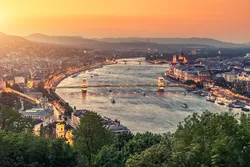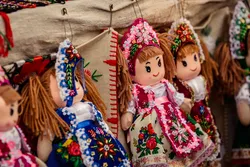See all articles relating to: Hungary

Hungary is a Central European country. The Magyars, a nomadic people, arrived in the Carpathian Basin in the late 9th century and founded the Kingdom of Hungary. Over the centuries, Hungary has been shaped by a variety of influences, including the Ottoman Empire, Habsburg rule, and Soviet domination after World War II. Hungary played a key role in the resistance against the Soviet regime when the 1956 Hungarian Revolution erupted, resulting in a brutal suppression of the uprising. Famous figures in Hungarian history include King Stephen I, who was the first Christian king of Hungary and is credited with founding the Hungarian state; Lajos Kossuth, a statesman and leader of the Hungarian Revolution of 1848; and Raoul Wallenberg, a Swedish diplomat who saved thousands of Hungarian Jews during World War II.
Research your ancestors on MyHeritage
Hungarian historyHungarian history
Hungary has been inhabited by recognizably modern humans for tens of thousands of years. The first well-developed culture to emerge here was the Vučedol culture, which was making distinctive pottery and ornamental swords and axes at roughly the same time the Pyramids were being built in Egypt 4,500 years ago.[1] Later the Pannonian Plain was settled by a mix of Celts and Germanic peoples such as the Marcomanni. The region was conquered by the Romans in the late first century BCE and early first century CE and became a part of the northern frontier of the empire along the course of the River Danube.
Hungary was a center of aggression against the Romans from the second century CE onwards, first in the shape of the Marcomanni who penetrated the border and engaged in an extensive war against the Romans during the reign of Emperor Marcus Aurelius in the 160s and 170s CE. More significantly, from the late fourth century CE onwards the area became the heartland of the empire of the Huns, who threatened the very survival of the empire throughout the first half of the fifth century. The lowlands of the Great Hungarian Plain within the wider Carpathian Basin were ideal terrain for the Hun cavalry to operate from.[2]
Following the collapse of the Roman Empire in the west the great plains here were inhabited by a range of different ethnic groups, notably the Slavs, but all of these were displaced in the ninth century when the Magyars, one of Europe’s most mysterious invaders the origins of which are unclear, arrived to the region. They settled lands which are roughly approximate to modern-day Hungary and it is from this point onwards that it becomes plausible to speak of a Hungarian nation. Indeed the word Hungary comes from a term used by the Byzantines in Constantinople to describe the Magyars. A Kingdom of Hungary soon emerged under them and reached a position of considerable prominence in Europe under rulers like King Béla III in the twelfth century, though a half a century later it became the westernmost state to experience an incursion by the Mongols during their enormous series of conquest.[3]

Hungary was subject to conquest yet again in the sixteenth century when King Louis II of Hungary was defeated in battle by the Ottoman Turks at the Battle of Mohács in 1526. Most of Hungary was incorporated into the Ottoman Empire and would remain so until the eighteenth century, though the crown of Hungary passed to the Austrian Habsburgs.[4] Later when the Austrians were able to begin pushing the Ottoman border southwards into the Balkans they reacquired Hungary. Its position as a prominent part of the Austrian Empire was recognized in 1867 when the Austrian Empire became the dual Empire of Austria-Hungary.
Hungary became an independent state yet again in the aftermath of the First World War. Like most other Central European states it drifted towards far-right, nationalist politics in the interwar period and allied with Nazi Germany during the Second World War. It was occupied by the Soviets as the conflict came to an end and was consequently pulled into the Eastern Bloc and the Warsaw Pact during the Cold War, despite an effort to throw off Russian rule in an uprising in 1956. Since the end of the Cold War Hungary has joined the European Union, however under the rule of Viktor Orbán and Fidesz since 2010 the country has been viewed as a very problematic member of the European Union which leans too close to Russia and authoritarianism.[5]
Hungarian geographyHungarian geography

Hungary is a generally low-lying country, much of which is located in the Carpathian Basin, a substantial portion of which is made up of the Great Hungarian Plain. The average elevation across the country is just 200 meters, making it one of the lowest in Europe. It is dissected by two major rivers, the Danube and the Tisza, the city of Budapest lying along the course of the Danube and having evolved historically from two villages called Buda and Pest which amalgamated over time.[6] There is mountainous land to the west where the largest lake of Central Europe, Lake Balaton, is also located.[7] Because of its landlocked location a considerable distance from any major sea, Hungary has a mixed climate, with temperate, cold winters and warm continental summers. Budapest is by far and away the dominant city in the country, with some 1.8 million people living here or one in five Hungarians.
Researching family history in HungaryResearching family history in Hungary
There are various types of records available to help trace ancestry in Romania. These include civil registration records, church records, census records, property records, military records, and naturalization records. Civil registration records are especially valuable and can provide information on births, marriages, and deaths. Partial censuses have been taken in Hungary since the late seventeenth century. Yet this did not cover the whole country, much of which was under the rule of the Ottoman Turks at that time. The first full, official census dates to the mid-1780s , while these became more regular in the nineteenth century, as was the pattern with most European states. Unfortunately, though, Hungary’s censuses are amongst the least useful Europe-wide for genealogical research. For instance, the 1784 to 1785 census has only survived in a fragmentary form, while others are difficult to access and have not been digitized for the most part. Researchers working on Hungarian family history might usefully consult with the Hungarian National Archives.[8] A general guide for family researchers is available on their website.[9]
See also:
- Hungarian genealogy
- Hungarian immigration
- Hungarian emigration
- Hungarian archives
- Birth records in Hungary
- Death records in Hungary
- Marriage records in Hungary
- Census records in Hungary
- Civil registrations in Hungary
- Newspaper records in Hungary
- Hungarian church records-Catholic Church
- Hungarian church records-Reformed Church in Hungary
- Hungarian Jewish records
- Hungarian Church records-Unitarian Church of Transylvania
- Hungarian church records-Greek Catholic Church
- Hungarian military records
- Hungarian cemeteries
Hungarian ethnicityHungarian ethnicity
Hungary is a country with a rich ethnic mix. The majority of the population is Hungarian, with a small number of Germans, Slovaks, Romanians, and Croats also present. The largest minority group is the Roma. Other ethnic groups present in Hungary include Armenians, Greeks, Jews, Poles, and Serbs.
See also:
Hungarian surnamesHungarian surnames

Many Hungarian surnames are derived from Hungarian words and phrases, while others are of Slavic, German, or Romanian origin. For example, surnames ending in -ics, such as Kovács and Szabó, are often of Slavic origin, while those ending in -y or -i, such as Szekeres and Nagy, are typically Hungarian in origin. Understanding the history and meaning of Hungarian surnames can be helpful in researching family history and connecting with distant relatives.
See also:
Explore more about HungaryExplore more about Hungary
- Historical records from Hungary on MyHeritage
- Hungary's Secret: New Study by MyHeritage on the MyHeritage Blog
- Beginning Hungarian Genealogy at Legacy Family Tree Webinars
- 77 Years After the Holocaust, DNA Test Connects Survivor with Descendants of Surviving Relatives on the MyHeritage Blog
ReferencesReferences
- ↑ https://www.ancient-origins.net/ancient-places-europe/vucedol-culture-rise-iconic-copper-age-culture-croatia-006842
- ↑ https://www.history.com/topics/ancient-china/huns
- ↑ https://www.newworldencyclopedia.org/entry/Magyars
- ↑ https://www.britannica.com/event/Battle-of-Mohacs
- ↑ https://www.bbc.com/news/world-europe-17383522
- ↑ https://www.countryreports.org/country/Hungary/geography.htm
- ↑ https://www.britannica.com/place/Lake-Balaton
- ↑ https://mnl.gov.hu/angol
- ↑ https://mnl.gov.hu/angol/mnl/ol/family_research

